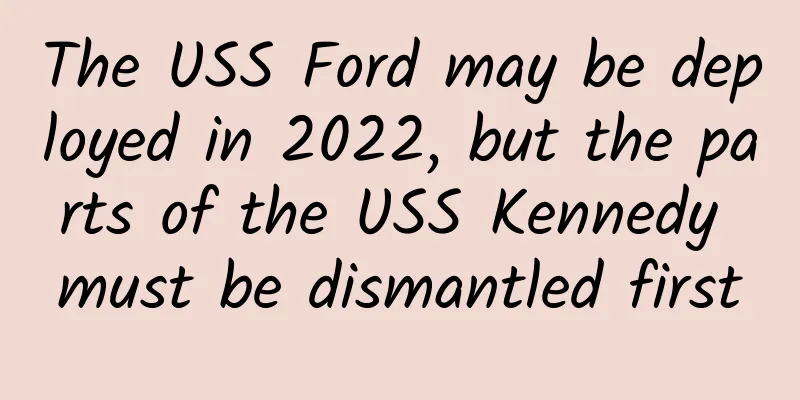The USS Ford may be deployed in 2022, but the parts of the USS Kennedy must be dismantled first

|
According to the U.S. Naval Institute (USNI) website on October 25, 2021, the U.S. Navy will deploy the USS Ford (CVN-78) for the first time in 2022, which makes the deployment of this type of aircraft carrier four years later than the original schedule of 2018. The parts come from the future U.S. aircraft carrier USS John F. Kennedy (CVN-79), the second of the Ford-class aircraft carriers currently under construction at Huntington Ingalls Industries' Newport News Shipbuilding & Dockyard in Newport News, Virginia. Capt. Clay Doss, a Navy acquisition spokesman, told USNI News that the parts Ford received from Kennedy ranged from pumps to limit switches. “These parts include HMI screens for shop elevators, as well as motor controllers, power supplies, small pumps, limit switches and valve actuators for various systems throughout the ship,” Doss said. “This is not uncommon early in a program and will occur less frequently as supply support matures.” Doss described the decision to provide some parts for the Ford from the Kennedy as a "project management tool" that the Ford uses on various projects. “This will only occur after it is confirmed that the part or material is not available in the supply system and/or there is no alternative source,” Doss told USNI News. “A replacement plan must be in place for each case. None of the parts transferred to CVN 78 Ford are expected to impact the construction schedule for CVN 79 Kennedy.” The U.S. Navy signed a contract with Newport News Shipbuilding in 2009 to build the USS Kennedy, and on February 25, 2011, the first steel plate was cut, officially starting construction of the USS Kennedy. The picture shows the naming ceremony of the USS Kennedy after it was launched in December 2019 On February 25, 2011, the Newport News Shipyard held a ceremony to cut the first steel plate for the second Ford-class aircraft carrier (CVN79). In a separate statement, Naval Sea Systems Command said the procedures were in compliance with Navy maintenance rules. “Per the Navy’s Combined Fleet Maintenance Manual, the use of same-type kits is part of the process to enhance CVN 78’s readiness and is initiated only after material is determined to be unavailable in the supply system or after verification that there is no alternative source,” Alan Baribeau, a spokesman for Naval Sea Systems Command, told USNI News in a statement. (In other words, Ford currently has no spare parts.) The lead ship, Ford, has faced multiple delays and struggled with the reliability of several new technologies aboard and is due to be deployed in 2022, U.S. Naval Institute News recently reported. In June, Vice Admiral Andrew Lewis, commander of the U.S. Navy's 2nd Fleet, presided over a change of commander ceremony at the Norfolk Naval Base: appointing Brigadier General Gregory Huffman to replace Brigadier General Craig Clapperton as commander of the 12th Carrier Strike Group (CSG-12). At the same time, he announced that the USS Ford (CVN-78) and the 8th Carrier Air Wing (CVW-8) were officially assigned to the 12th Carrier Strike Group. The combat direction is the jurisdiction of the 2nd Fleet (from the US East Coast to the Atlantic Ocean), the 6th Fleet (from the Atlantic Ocean to the Suez Canal), and the 5th Fleet (from the Suez Canal to the North Arabian Sea). This also means that the USS Ford will stay away from the Asia-Pacific region for a considerable period of time in the future. The Ford will carry the 8th Carrier Air Wing. A U.S. Navy air wing is a wing with four strike fighter squadrons. A squadron has 10 F-18s and 14 F-35Cs (recently changed). It is currently uncertain whether the Ford can carry the F-35C. A Huntington Ingalls Industries spokesman said the shipbuilder and the Navy are establishing a supply network for the carrier class so the ships can get spare parts. “A common shipbuilding practice for the first ship in a new class is to share parts between ships to maximize readiness until a supply system for the entire class is established,” Duane Byrne told USNI News. “A small portion of material aboard USS John F. Kennedy (CVN 79) has been used on the lead ship of the Ford-class aircraft carrier, USS Gerald R. Ford (CVN 78), without impacting the schedule. We are working with our Navy customer to establish a supply system that includes Ford-class parts.” In other words, the U.S. Navy is currently experiencing problems with its supply of parts due to supply chain shocks. The ship is currently in port for a six-month maintenance phase known as Planned Incremental Availability, after completing shock trials this summer. "Everything is on track. We still expect to leave as planned after the six-month availability period. They haven't had any major events at all. So it's been very, very positive news from the captains and the shipyards. And then as we get out of this, I think we'll be ready to get back to the operational mindset and be ready to deploy," Rear Adm. Gregory Huffman, commander of Carrier Strike Group 12, who will lead the Ford's first deployment, told USNI News in an interview last month. While the Navy previously planned to deliver the USS Kennedy in two different phases as a cost-saving measure, the Navy switched to a single-phase delivery approach last year. Under the new plan, the Navy will receive the USS Kennedy and make all necessary modifications to accommodate the F-35C Lightning II Joint Strike Fighter. The shift came after lawmakers inserted a provision into the fiscal 2020 defense policy bill that would require the USS Kennedy to be able to deploy the F-35C before completing the availability phase of the commissioning phase. The emergence of this bill is also the reason why many people speculate that the USS Ford cannot currently use the F-35C. If there is no problem with the Ford class, why is it necessary to issue a separate bill to ensure the availability of the F-35C on the second Ford-class aircraft carrier, the USS Kennedy? An F-35C Lightning II from Strike Fighter Squadron (VFA) 147, the "Argonne Heroes" (left), an F/A-18F Super Hornet from VFA 2, the "Bounty Hunters" (center), and an F/A-18E Super Hornet from VFA 113, the "Ghost Hunters" (right), sit on the flight deck of the aircraft carrier USS Carl Vinson (CVN-70). U.S. Navy photo The Navy will partially address the strike fighter shortage by changing how it deploys the F-35C Lightning II Joint Strike Fighter by 2025. Instead of two 10-plane F-35C squadrons per air wing, the Navy will give each carrier air wing a 14-fighter F-35 squadron, Rear Adm. Andrew Loiselle, director of the Air Force Operations Division (OPNAV/N98), told a House Armed Services subcommittee. It will reduce the F-35C Lightning II Joint Strike Fighter from two squadrons per air wing to one squadron. In this case, in the next few years (at least until 2035, if the sixth-generation aircraft of the US Navy goes smoothly), the four strike fighters of the US aircraft carrier strike group and the carrier-based aviation force will be one F-35C squadron (14 aircraft) and three "Super Hornet" squadrons (10 aircraft). “Under the single-phase delivery schedule, Kennedy will deliver the complete combat system and Joint Strike Fighter (F-35C) capability required by the National Defense Authorization Act in 2024,” Byrne told USNI News. First of all, it can be seen that the progress of the Ford is really not very smooth. Because the Ford uses a lot of new technologies, it has "taken too big a step and hurt the balls." The U.S. Navy Chief of Operations, Admiral Gilday, once said that the Navy has learned a lesson from the Ford. Gilday said that with nearly two dozen unproven new technologies being incorporated into the Ford class, which has led to numerous shipbuilding delays, cost overruns and consternation among members of Congress, the Navy is taking a "much more thoughtful approach" in its plans to introduce new technologies into its platforms. "I think the industry is in full agreement that we really shouldn't be introducing more than one or two new technologies into any complex platform like this to make sure that we keep the risk at a manageable level," Gilday said. The U.S. Navy even lost a Navy Secretary for this. On November 24, 2019 local time, U.S. Secretary of Defense Esper asked U.S. Navy Secretary Spencer to resign. Subsequently, U.S. President Trump confirmed the news on social media and nominated a new Navy Secretary. The Navy Secretary issued a "military order" in front of Trump in January 2019: According to a report on the U.S. Naval Institute website on January 8, 2019, the U.S. Navy Secretary promised that by the end of summer 2019, the Navy and shipyards will solve the problem of the instability of the advanced weapon elevators of the USS Ford (CVN-78). Otherwise, Trump can "fire him." Then he was fired. The Kennedy mentioned in the article is being delivered in two steps, and will be delivered in advance. It will be delivered to combat deployment faster than the first ship, the Ford. One factor is to dispel the doubts of members of Congress about the Ford class. Another thing is that the U.S. Navy is really short of aircraft carriers, and some of them can no longer hold on. An illustration of the CVN-79 Kennedy. The Kennedy (CVN-79) is expected to be delivered in 2022 and deployed in 2024. It will replace the Nimitz (CVN-68) which will be retired by then. The USS Nimitz is the first ship of the Nimitz-class aircraft carrier. It was commissioned on May 3, 1975. Today, it is 46 years old and can no longer withstand the high-intensity use. Recently, there have been problems with the ship just after the overhaul, and it has to be repaired again. The USS Nimitz (CVN-68) is back in port after experiencing a "minor material defect" in its propulsion unit, according to the U.S. Navy. "On November 7, 2021, the USS Nimitz (CVN 68) was transiting in international waters off the west coast of the continental United States when a minor material defect was discovered in the propulsion unit during normal operations," Cmdr. Zach Harrell, a spokesman for the U.S. Naval Aviation Force, said in a statement. "The ship's crew took action to correct the deficiency and the ship returned to port. The defect did not pose a danger to the ship, propulsion unit, crew or environment." CVN-68 Nimitz is the first Nimitz-class aircraft carrier The USS Nimitz has been under maintenance in Bremerton, Washington, since returning home from a long deployment in March. The carrier left port for the first time on Saturday, meaning the crew discovered the power plant's shortcomings a day after work began, according to the Kitsap Sun, a newspaper that frequently covers U.S. Navy news. "Puget Sound Naval Shipyard and the Intermediate Maintenance Facility will conduct a comprehensive assessment of the USS Nimitz and perform any necessary repairs prior to the carrier's next sailing period," Harrell said in a statement. Harrell said that aside from the reactor issues, planned maintenance and sea trials to test repairs have been completed. According to reports, the Nimitz encountered problems during sea trials right after an overhaul and was sent directly back to the factory. The Kitsap Sun first reported the propulsion unit defect and the return of the USS Nimitz to port. The author will not deny the strength of the US Navy and its shipbuilding capabilities. The fact that there are currently three aircraft carriers under construction is the best proof of this. However, the United States' current poor project management and supply chain problems are truly shocking. |
>>: Snow White is real, and the magic mirror is really weird
Recommend
What aspects should companies consider before developing an APP?
Nowadays, all enterprises are moving towards mobi...
The Internet Profit Model from the Perspective of Dedao App
There is no unified way to classify profit models...
Can laser combs help hair grow? Huaxi experts: Before taking care of your hair, first understand these 4 facts!
For the delicate little fairy, There is something...
Chats can be encrypted! Tencent launches WeChat message encryption app "MiXin"
Recently, Tencent launched a mini program called ...
Hello 5C, Goodbye 5C.
According to Taiwan's Commercial Times, Apple...
What is the difference between Cordyceps sinensis and Cordyceps sinensis? What is the difference between Cordyceps sinensis and Cordyceps sinensis?
People who have been practicing health preservati...
Why are more and more strong typhoons coming earlier?
A strong typhoon is a tropical cyclone with great...
A magnetar was discovered in the Milky Way, producing strong radio bursts, only 30,000 light-years away from us
[Mobile software: Bo Ke Yuan] Using the Canadian ...
6 major trends in social media and digital marketing in 2022!
The author of this article combines the current s...
Competitive product analysis: Pinduoduo and Taobao's money-saving monthly cards
I am a heavy user of Taobao. Since I bought a mon...
Is the promotion cost too high? You need to build a self-growth operating system
Recently, I have received a lot of inquiries abou...
Kuku said that money created a Douyin account and on the 4th day, a project that everyone can copy was exposed
Kuku said that money had set up a Douyin account ...
CES 2016 preview: Automotive technology and augmented reality will take center stage
[[161239]] Every year at the beginning of the year...
Huanqiu Auto, Volvo Cars and 5 Chinese smart service providers jointly discussed smart cars - "What kind of smart car do we need in the future" summit forum was held in Beijing
On December 11, the "Open, Standard, and Saf...
Are all astronomical telescopes expensive? There are some mobile ones that are very cheap
The deep and dark universe seems to hide many sec...









